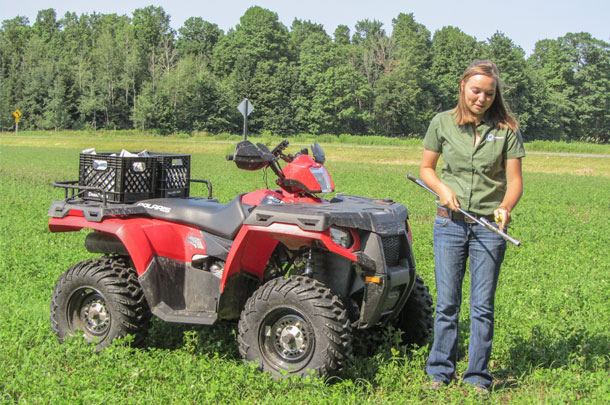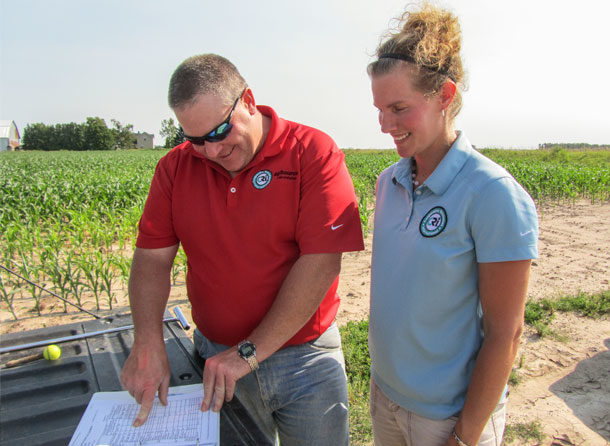Global positioning systems (GPS) and nutrient management plans (NMP) line up with variable rate technologies (VRT) to provide better management of cropland from A to Z.
Soil testing
In many instances, growers are sampling their soils using smaller grids, which gives them more data points and more specific information in their fields. This helps them maximize the use of variable rate technology for their fertilizer applications.
In addition, many growers are taking samples more often, down to every three or every two years, rather than waiting every four years, because they want to make good fertilizer decisions. People are paying more attention to this data, agronomists say.
Chuck Bolte, GPS/NMP manager for AgSource Laboratories, notes that 20 years ago, the farmers he worked with were sampling soils at 5-acre intervals. Today, about half of them are sampling at twice that intensity – a 2.5-acre grid – and some are sampling on a 1.1-acre grid. “That’s because farmers see the value in it,” Bolte says.
One thing he always counsels his growers is that variable rate technology doesn’t necessarily mean using less fertilizer. It means using it on the parts of the field where the nutrients are needed the most. There are the parts of the field that are likely going to always need more fertility. “Because these areas are working the hardest – producing the greatest yield,” he says. “And soil testing can show the growers where those zones are.”
Today’s technology allows growers and their crop advisers to create soil map layers and use information technology to visualize management zones within their fields. This information dovetails perfectly with variable rate planting and fertilization programs.
Hay growers can take advantage of variable rate lime and potash applications ahead of planting alfalfa. Soil pH is extremely critical for alfalfa stand establishment and yield. “To get high-quality and high-yielding alfalfa, you need to fertilize,” Bolte says. “Variable rate liming is one of the biggest bangs for the buck that you can get with this technology, but variable rate potash application can be very valuable also.”
Soil pH and potash are critical pieces of the puzzle. Healthier plants can overwinter and survive soilborne diseases better.
Micronutrients like boron and sulfur are also important and should be part of any alfalfa management plan.
The current generation of fertilizer spreaders used by co-ops and farm supply services can spread two to four products at once. Crop advisers can hand the co-op manager a flash drive, preloaded with field data, and the driver puts it in the truck and then just drives. The system determines how much material to spread and where to spread it.

Aerial imagery
Aerial imagery is another way that farmers are adding a layer of information to the data points they get from their yield monitoring and soil testing, says Christine Clark, territory sales representative and a certified crop adviser (CCA) with AgSource Laboratories in Bonduel, Wisconsin.
Information is available by satellite imagery from many sources at low cost, but clouds can get in the way and you can go weeks without images. Imagery by drones or airplanes is more reliable, but costs are much higher.
The aerial images may simply show the farmer that he is doing a good job, Clark says, and reveal that “there’s nothing to fix,” or it may offer insight into where management needs to be more intensive – suggesting that the agronomy team needs to tweak the sampling points in each field.
This imagery works using NDVI (normalized difference vegetation index), which quickly and simply identifies vegetated areas and their condition; it creates data files based on shades of green. It can show, for example, where there are soil compaction problems and can illustrate for growers how it looks when hay is chopped off with vehicles passing along the edge of the field or all across it, Clark says.
One recent aerial image was taken of an irrigated field where one triangle was a different color. When the farmer investigated at ground level, he found the small area was the only spot that was getting the right amount of water. That imagery alerted the grower to fix the irrigation problem.
The information matrix formed by all the tests and aerial imagery can also alert growers to early nutritional deficiencies in their fields. “You may not notice it, but the program is going to connect all the colored areas that are the same,” she says.
More and more growers are using these layers of information to create management zones. Armed with that information, they don’t treat the whole field in the same way, but use different levels of nutrients or management or micronutrients to get the best results.
“The lab results also tie into varieties of forage crops that farmers use, like Roundup Ready alfalfa or brown mid-rib silage corn. Some newer hybrids are nutrient hungry, and growers can get bigger yields using soil data to feed them properly,” Clark says.
Other monitoring modes
In some cases, farmers or consultants have been taking samples in the same spot for 10 years or more using GPS, and this rich data file can show trends. “Potassium may be going up or down, or pH may have changed over time, or micronutrients may have changed. Once you overlay yield data, it provides a wealth of information,” Clark says.
Progress is being made on flow meters and variable rate technology for manure application as well, says Bolte. The data that farmers can get today can help them prioritize which fields get fertilized first or where to put manure, which is important when figuring out where manure will be most useful after each crop.
Many laboratories offer manure analysis, but this year’s results at AgSource have generally shown that manure is lower in nutrients, due to all the rain that has fallen into storage structures. The soil and manure testing together, Clark says, allows growers to adjust their manure spreading plans, based on good information.
Clark says the nutrient management planning staffers do a really good job of helping farmers realize that this NMP is a tool and should be used to manage their operation. It’s not just a plan to write and put on the shelf. ![]()

-
Jan Shepel
- Freelance Writer and Dairy Farmer
- Wisconsin
PHOTO 1: Chuck Bolte, AgSource GPS/NMP manager, and Christine Clark, AgSource sales representative, review soil test results in the field.
PHOTO 2: GPS soil sampling provides a foundation for good nutrient management planning. Photos courtesy of AgSource Laboratories.












